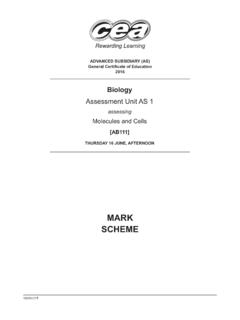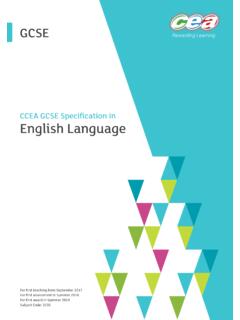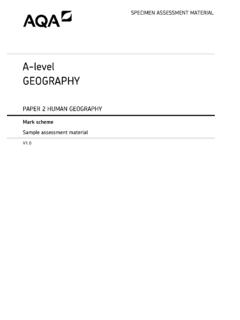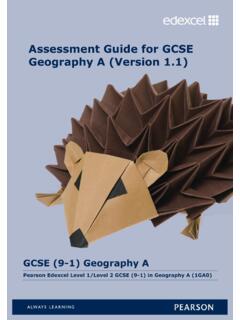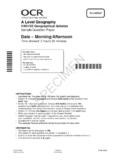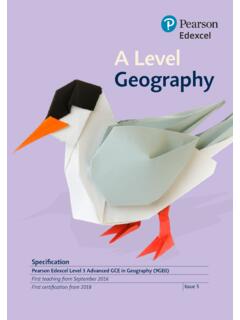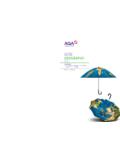Transcription of CCEA GCSE Specimen Assessment Materials for Geography
1 GCSE. CCEA GCSE Specimen Assessment Materials for Geography For first teaching from September 2017. For first Assessment in Summer 2018. For first award in Summer 2019. Subject Code:3910. Foreword CCEA has developed new specifications which comply with criteria for GCSE qualifications. The Specimen Assessment Materials accompanying new specifications are provided to give centres guidance on the structure and character of the planned assessments in advance of the first Assessment . It is intended that the Specimen Assessment Materials contained in this booklet will help teachers and students to understand, as fully as possible, the markers'. expectations of candidates' responses to the types of tasks and questions set at GCSE level. These Specimen Assessment Materials should be used in conjunction with CCEA's GCSE. Geography specification. BLANK PAGE. GCSE Geography Specimen Assessment Materials Contents Specimen Papers 3. Unit 1: Understanding Our Natural World 3. Unit 2: Living in Our World 29.
2 Insert: A3 Ordnance Survey Map: Durham 49. Unit 3: Fieldwork 51. Mark Schemes 59. General Marking Instructions 61. Unit 1: Understanding Our Natural World 65. Unit 2: Living in Our World 81. Unit 3: Fieldwork 99. Subject Code 3910. QAN 603/1080/7. A CCEA Publication 2017. You may download further copies of this publication from Specimen PAPERS. DIVIDER FRONT. Specimen PAPERS. DIVIDER BACK. Centre Number Candidate Number General Certificate of Secondary Education 2018. Geography Unit 1. Understanding Our Natural World [CODE]. Specimen paper . TIME. 1 hour 30 minutes. INSTRUCTIONS TO CANDIDATES. Write your Centre Number and Candidate Number in the spaces provided at the top of this page. Write your answers in the spaces provided in this question paper . Answer all four questions. INFORMATION FOR CANDIDATES. The total mark for this paper is 100. Figures in brackets printed down the right hand side of pages indicate the marks awarded to each question or part question . For Examiner's Quality of written communication will be assessed in questions 1(e), use only 2(f) and 3(f).
3 question Marks Number 1. 2. 3. 4. Total Marks 3. Theme A: River Environments Examiner Only Marks Re-mark 1 (a) Study Fig. 1 below which shows a drainage basin. Answer the questions which follow. B C. D. E. A land sea Key A Where the river enters the sea. B The start of a river. High ground which separates one C . drainage basin from another. D Where two rivers meet. tributary A small river which joins the E . main river. Fig. 1 CCEA. (i) Complete the key for Fig. 1 by labelling features A-D. Choose your answers from the list below. One has been completed for you. flooding confluence watershed mouth source [4]. (ii) State the meaning of the term infiltration. [2]. 4. (b) Study Fig. 2 below which shows how load size varies with distance Examiner Only from the source of the Colin River in Belfast. Answer the question Marks Re-mark which follows. 60. 50. 40. average size of load (cm). 30. lin eo fb es t fi t 20. 10. 0. 0 1 2 3 4 5 6. distance from river source (km). Fig. 2. Describe how load size varies with distance from the source of the Colin River.
4 [4]. 5. (c) Study Fig. 3 below which shows a river meander. Answer the Examiner Only question which follows. Marks Re-mark CCEA. Fig. 3. Explain how a meander is formed. [5]. 6. DO NOT WRITE ON THIS PAGE. (Questions continue overleaf). 7. (d) Study Fig. 4 below which shows three flood prevention methods. Examiner Only Answer the question which follows. Marks Re-mark Department of the Interior Bureau of Reclamation Dam By permission of Forest Service NI , an Agency of the Department of Agriculture, Environment and Rural Affairs Afforestation CCEA. Embankment Fig. 4. 8. Choose one of the flood prevention methods shown in Fig. 4 on the Examiner Only previous page, and explain one way in which it might help to reduce Marks Re-mark the flood risk on a river. Chosen flood prevention strategy [3]. 9. (e) With reference to a river in the British Isles, explain the physical and Examiner Only human causes of a flood on your named river. Marks Re-mark Name of river: Causes of the flood: [7]. Extra space 10.
5 Theme B: Coastal Environments Examiner Only Marks Re-mark 2 (a) Study Fig. 5 below which shows a stretch of coastline in Greece. Answer the question which follows. siete_vidas / iStock / Thinkstock Fig. 5. Name two coastal landforms shown in Fig. 5. 1. 2. [2]. 11. (b) Coastlines can be shaped by constructive and destructive waves. Examiner Only Marks Re-mark Complete the following sentences to compare constructive and destructive waves. Choose your answers from the list below. constructive destructive erode build up less more 1. In waves the backwash is stronger than the swash. 2. waves are low and far apart. 3. Destructive waves are frequent than constructive waves. 4. Constructive waves the beach. [4]. (c) Explain how hydraulic action causes erosion at the coast. [3]. (d) State three reasons why a coastline may need to be defended. 1. 2. 3. [3]. 12. (e) Study Fig. 6 below which shows a spit. Answer the question which Examiner Only follows. Marks Re-mark Jupiterimages / Stockbyte / Thinkstock Fig.
6 6. Explain how a spit is formed. [5]. 13. (f) With reference to a case study from the British Isles, evaluate the Examiner Only sustainability of a coastal management strategy you have studied. Marks Re-mark [8]. Extra space 14. Theme C: Our Changing Weather and Climate Examiner Only Marks Re-mark 3 (a) Study Table 1 below which shows two weather recording instruments. Answer the question which follows. Table 1. IMAGE OF NAME OF ELEMENT UNIT OF. INSTRUMENT INSTRUMENT RECORDED MEASUREMENT. AIR. PRESSURE. ANEMOMETER KNOTS. CCEA. Complete Table 1 by writing the correct answers in the blank boxes. [3]. 15. (b) Study Table 2 below which shows the main air masses that affect the Examiner Only British Isles. Marks Re-mark Complete Table 2 by drawing an arrow to match up each air mass with its correct description. One has been completed for you. [3]. Table 2. Air Mass Description Tropical Maritime Most common air mass affecting the British Isles. The air mass travels over the Atlantic Ocean bringing cold and wet conditions.
7 Tropical Continental Least common air mass affecting the British Isles. The air mass usually only occurs during summer when it brings hot and dry conditions. Polar Maritime This air mass originates over Northern Europe. It brings cold and dry conditions. Polar Continental This air mass travels from the south- west bringing warm and wet weather in summer. 16. (c) The Met Office uses images from satellites, such as the one shown in Examiner Only Fig. 7 below to help create weather forecasts. Answer the questions Marks Re-mark which follow. 3 DSculptor / iStock / Thinkstock Fig. 7. (i) State the type of satellite which is fixed in the same location in space. [1]. (ii) Explain how satellites help to create a weather forecast. [3]. (d) State two factors that affect climate. 1. 2. [2]. 17. (e) Study Fig. 8 below which shows a weather map and information Examiner Only about a weather system over the British Isles on Wednesday 16th Marks Re-mark December 2009. Answer the questions which follow.
8 1036. H. 1032. 1028. 1024. N. Wednesday 16th December 2009 1028 air pressure Forecasters have warned that the weather in Britain is set to turn cold this weekend. Temperatures will fall to as low as 5 C in London and 2 C in Edinburgh by Sunday. Over the next few days the country will experience dry, calm and cold conditions. CCEA. Fig. 8. (i) State the type of weather system over the British Isles on Wednesday 16th of December 2009. [1]. 18. (ii) Explain why the British Isles experienced dry and calm conditions Examiner Only on Wednesday 16th of December 2009. Marks Re-mark Dry conditions: Calm conditions: [6]. 19. (f) With reference to a case study from outside the British Isles, Examiner Only describe the impacts of an extreme weather event on people and Marks Re-mark property. [6]. Extra space 20. Theme D: The Restless Earth Examiner Only Marks Re-mark 4 (a) Study Fig. 9 which shows the structure of the earth. Answer the question which follows. X. Y. Dorling Kindersley / Thinkstock Fig.
9 9. Name the layers of the earth labelled X and Y. X =. Y = [2]. 21. (b) Plates are continually moving. Examiner Only Marks Re-mark Complete Table 3 below by putting the statements in the correct order to show how plates move. One has been completed for you. Table 3. The molten material cools and sinks back down dragging the plates along. Convection currents in the mantle move magma upwards. Plates float on the surface of the mantle. 1. These currents spread out at the surface underneath the plates. [3]. 22. (c) The earth's crust is made up of many different types of rock. Answer Examiner Only the questions which follow. Marks Re-mark (i) Complete Table 4 below by stating one other example of both an igneous and a sedimentary rock. Table 4. Igneous Sedimentary Granite Sandstone [2]. (ii) Explain how sedimentary rocks are formed. [3]. 23. (d) An earthquake is a sudden movement within the earth's crust. Study Examiner Only Fig. 10 below which shows damage caused by an earthquake. Marks Re-mark Answer the questions which follow.
10 Naypong / iStock / Thinkstock Fig. 10. (i) Using Fig. 10, outline one short term impact this damage could have on the economy of the area. [2]. (ii) Describe one long term strategy which could improve safety in an earthquake prone area. [3]. 24. (e) (i) Different types of volcanoes have different characteristics. Examiner Only Complete Table 5 below using a tick ( ) to match each Marks Re-mark characteristic with the correct type of volcano. Table 5. Characteristic Shield Composite Volcano Volcano The volcano has steep slopes and a narrow base. Eruptions are frequent and non-violent. The peak is low and rounded. Occurs at destructive plate boundaries. [4]. (ii) Discuss the potential global impact on people and the environment of a supervolcano eruption. [6]. 25. Extra space Examiner Only Marks Re-mark 26. THIS IS THE END OF THE question paper . 27. BLANK PAGE. 28. Centre Number Candidate Number General Certificate of Secondary Education 2018. Geography Unit 2. Living in Our World [CODE].





